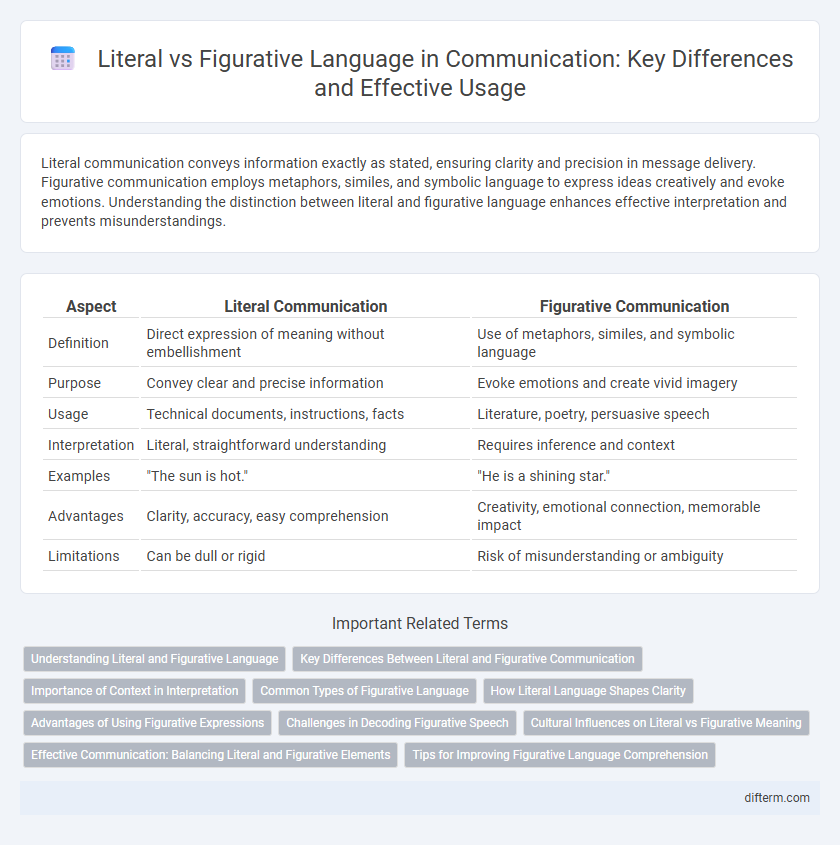Literal communication conveys information exactly as stated, ensuring clarity and precision in message delivery. Figurative communication employs metaphors, similes, and symbolic language to express ideas creatively and evoke emotions. Understanding the distinction between literal and figurative language enhances effective interpretation and prevents misunderstandings.
Table of Comparison
| Aspect | Literal Communication | Figurative Communication |
|---|---|---|
| Definition | Direct expression of meaning without embellishment | Use of metaphors, similes, and symbolic language |
| Purpose | Convey clear and precise information | Evoke emotions and create vivid imagery |
| Usage | Technical documents, instructions, facts | Literature, poetry, persuasive speech |
| Interpretation | Literal, straightforward understanding | Requires inference and context |
| Examples | "The sun is hot." | "He is a shining star." |
| Advantages | Clarity, accuracy, easy comprehension | Creativity, emotional connection, memorable impact |
| Limitations | Can be dull or rigid | Risk of misunderstanding or ambiguity |
Understanding Literal and Figurative Language
Understanding literal and figurative language enhances communication by distinguishing direct meanings from symbolic expressions. Literal language conveys explicit, precise information, while figurative language uses metaphors, similes, and idioms to evoke imagination and emphasize concepts. Mastery of both forms improves comprehension, interpretation, and effective expression in diverse communicative contexts.
Key Differences Between Literal and Figurative Communication
Literal communication conveys exact meanings by using words in their strictest sense, ensuring clarity and minimizing misunderstanding. Figurative communication relies on metaphors, similes, and symbolism to express ideas indirectly, often adding emotional depth or creative nuance. Key differences include the directness of literal language versus the interpretive nature of figurative language, impacting how messages are decoded and understood in conversations.
Importance of Context in Interpretation
Interpreting language relies heavily on context, as literal meanings often differ significantly from figurative expressions. Context provides critical cues that guide understanding, preventing miscommunication by clarifying intended meanings behind metaphors, idioms, or sarcasm. Effective communication depends on recognizing these nuances to convey and interpret messages accurately in diverse social and cultural settings.
Common Types of Figurative Language
Common types of figurative language include metaphors, similes, personification, and hyperbole, each enhancing communication by adding depth and creativity. Metaphors directly compare two unlike things to reveal hidden similarities, while similes use "like" or "as" for explicit comparisons. Personification attributes human qualities to non-human entities, and hyperbole involves deliberate exaggeration to emphasize a point.
How Literal Language Shapes Clarity
Literal language enhances clarity by using words in their most direct and explicit meanings, minimizing ambiguity in communication. It allows speakers and writers to convey precise information that can be easily understood by diverse audiences, ensuring the intended message is accurately received. This clarity supports effective instructions, factual descriptions, and technical explanations in various fields such as education, law, and science.
Advantages of Using Figurative Expressions
Figurative expressions enhance communication by conveying complex ideas and emotions vividly, making messages more memorable and engaging. They foster deeper understanding and cultural connection through metaphor, simile, and symbolism, enriching the listener's or reader's interpretative experience. This linguistic creativity simplifies abstract concepts, facilitating clearer and more impactful expression than literal language alone.
Challenges in Decoding Figurative Speech
Decoding figurative speech presents challenges due to its reliance on context, cultural nuances, and implied meanings that differ from literal interpretations. Listeners often struggle to infer metaphors, idioms, or sarcasm without shared background knowledge or clear contextual cues. Misinterpretations occur frequently, impacting effective communication and understanding.
Cultural Influences on Literal vs Figurative Meaning
Cultural influences significantly shape how literal and figurative meanings are interpreted in communication, as idiomatic expressions and metaphors vary across societies. In high-context cultures, figurative language often conveys deeper cultural values and shared knowledge, while low-context cultures typically favor more literal and explicit communication. Understanding these cultural nuances enhances effective cross-cultural communication and reduces misinterpretation in global interactions.
Effective Communication: Balancing Literal and Figurative Elements
Effective communication requires balancing literal language, which provides clarity and precision, with figurative elements that enhance engagement and emotional resonance. Mastering this balance helps avoid misunderstandings while enriching the message through metaphors, idioms, and analogies. Skilled communicators adapt their language use based on context, audience, and purpose to ensure both accuracy and impact.
Tips for Improving Figurative Language Comprehension
Understanding figurative language enhances communication by enriching meaning beyond literal words. To improve comprehension, regularly expose yourself to diverse literary genres and practice interpreting metaphors, similes, and idioms within context. Engaging in discussions about figurative expressions and using visualization techniques also boosts interpretative skills and cognitive flexibility.
literal vs figurative Infographic

 difterm.com
difterm.com